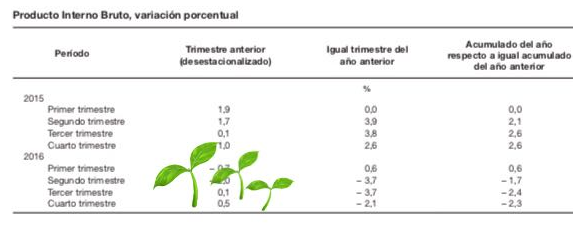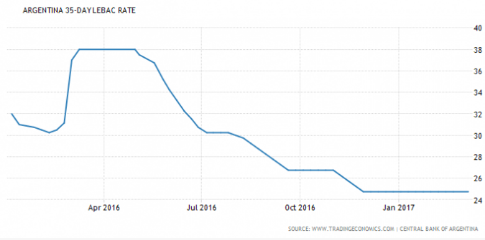How do you know when inflation is about 40%?
By Bianca Fernet, Argentina:
Hold on to your boots, you’re about to get some economic good news from Bianca Fernet.
Last week, our President Mauricio Macri sat down with Bloomberg to get mansplained while squinting into the sun give an interview on the state of Argentina’s economy and affairs. During this interview, Macri stated clearly and unequivocally that there is no need for a “Plan B” because the economy is already growing. I’m not going to lie, I was severely tempted to roll my eyes at this.
I’m still paying obscene prices for lettuce and dealing with butter shortages in the supermarket, and at the same time forced to deftly dodge these daily inane protests dedicated to cluttering the streets with tiny pieces of paper and noisy drum circles. Zero sarcasm, I could probably drum up a protest against protests with minimal effort.
So here’s some context for the answer to two questions:
- Is the economy really growing?
- In the grand scheme of things, is it enough?
1. Yes, The Economy Is Growing
A few weeks ago, Argentina’s National Statistics Agency INDEC released its Q4 2016 economic report showing that slowly but surely, Argentina’s economy had in fact begun to grow last year during the second half (see graph below). And of course, there was much rejoicing. International news outlets began to report that Macri had perhaps been right all along, and cocktail party banter turned to “green shoots”.

See? 0.1 percent and 0.5 percent growth in the third and fourth quarters of 2017, respectively. But you’ll also notice that column to the right of the artistic rendition of green shoots where it shows that the economy in fact shrunk when compared the same quarter the past year. The same report also highlights drops in some pretty key sectors of the economy, including manufacturing, mining, and construction.
Given Argentina’s long-standing history of fiddling with figures, I thought it prudent to get some context as to whether INDEC really had made sufficient changes to how it measures GDP growth to take this number seriously.
Inflation: What’s Real And What’s Nominal
If you’ve ever taken a basic economics class, you’ll vaguely remember that there were real and nominal values for economic indicators. Basically, nominal values are measured at a current price level and real values are adjusted for differences in price levels. This adjustment measure is called a GDP deflator and is basically a proxy for, you guessed it, inflation. So if you follow the theory, you’d measure the GDP in nominal terms at current price levels, adjust if for inflation, and voila, real GDP. So if inflation is being underreported, it then logically follows that real GDP would be overstated. And we’re still waiting until at least June 2017 to get annual inflation numbers from INDEC. Conundrum.
Even though it hasn’t started publishing annual inflation statistics yet, INDEC’s return to trustworthy methodology has been lauded by economically technical heavyweights. So after some pretty dry conversations indeed, in which I tried to casually bring up methodology, I spoke with analysts responsible for evaluating the INDEC GDP data for Capital Economics. The way INDEC calculates GDP growth exemplifies the challenges of working with emerging market datasets.
When INDEC measures GDP growth, they send out sector-specific surveys to businesses and other prominent actors. The information collected in these surveys goes far beyond prices. Depending on the industry and the kind of information that is available and/or relevant, these surveys seek out values, volumes, comparisons, output, production, quantities and investment levels. INDEC then converts these varying metrics, and applies a price deflator (which compensates for inflation) at a sector-specific level. This sector-specific data is then aggregated and weighted to calculate numbers for the economy as a whole.
So rather than calculate economy-wide inflation first and then use it to convert nominal values into real values, what happens is the GDP deflator across the data can be observed and then viewed as a proxy for inflation.
In the past, INDEC’s growth numbers reflected a deflator and thus inflation rate of around 15 percent per year. For this year’s estimates, the GDP deflator that has been used is roughly 40 percent – very close to private inflation estimates.
Private economists that have deemed INDEC’s GDP numbers kosher and have gone beyond comparing the deflator value to inflation or growth in prices. They have taken the industry specific data and compared it with numbers available in other industry reports, concluding that INDEC’s data is good to go.
2. Is Economic Growth Enough?
So despite high, rising price levels and a healthy dose of “unrest” still brewing in the streets, the economy is indeed growing. The green shoots are real.
And while critics and supporters alike are all looking to the congressional elections that will be held at the end of 2017 as the true bellwether for whether or not President Macri will “survive,” I’m in the positive outlook camp for a few key reasons.
- Neither the political situation nor economy have totally deteriorated, despite the variety of booby-traps worthy of an Indiana Jones movie that were left by the previous administration
- Macri may be delivering slightly less than he promised slightly later than he promised he would, but frankly in Argentina that’s pretty par for the course. In most emerging markets, things just take more time to get done. I’m not saying it always has to be that way, but Macri set out to accomplish something and he’s still on that track.
- INDEC’s methodology is producing reliable information, which is absolutely indispensable to acknowledging problems, identifying their roots and bringing about action
As Macri said in his interview with Bloomberg, he’s changed the tendency. It’s not enough, but it should not be written off.
What Are The Next Economic Hurdles?
Just because the economy is growing, it does not mean the most pressing issues have been dealt with. While inflation is the headline grabber, a related and important hurdle to normal economic functioning is the interest rate.

In order to restore lending and access to financing, Argentina’s interest rate has got to come down from near 25 percent, where it’s been hovering since December 2016. In addition, the fiscal burden caused by high government spending on subsidies and state employees is inflationary.
That being said, we’ve covered a tremendous amount of ground over the past 18 months, and President Macri’s accomplishments and determination are equally commendable.
As a message straight to you President Macri, The Bubble promises when you grant us a video interview, we’ll bring you some sunglasses. Bianca out. By Bianca Fernet, Argentina.
Enjoy reading WOLF STREET and want to support it? You can donate. I appreciate it immensely. Click on the mug to find out how:
![]()


The entirety of the modern economic model for the “developed” economies is bogus, to say the least. There is growth to be sure but the growth is anemic. At the same time central banks have bought so much debt that what little growth resulted from it is sure to be temporary once interest rates really start to rise.
‘In addition, the fiscal burden caused by high government spending on subsidies and state employees is inflationary.’
I don’t know if things have changed but a few years ago I read that half the workforce of Buenos Aires province worked for the government.
The insidious thing about a level of same above 25% is that they vote as a bloc and corrective feedback to the system via the ballot box becomes impossible. But since the government employees don’t generate enough REAL wealth to pay them- the government borrows or prints the difference. This goes on until it can’t and the economy collapses.
This happened in Argentina, although perhaps a little short of the full blown ‘Venezuela Syndrome’
Let’s hope it can be turned around and that Argentina’s agricultural sector doesn’t have to keep supporting an army of bureaucrats.
Nick, good comments.
” ‘In addition, the fiscal burden caused by high government spending on subsidies and state employees is inflationary.’ ”
Wow! This sounds so much like Canada, especially Ontario.
“…read that half the workforce of Buenos Aires province worked for the government.”
Again, another similarity to Ontario: there are 1.8 million people working for the provincial gov’t of Ontario right now, a province with a population of about 13.5 million.
And finally, “…above 25% is that they vote as a bloc and corrective feedback to the system via the ballot box becomes impossible.” That is exactly the situation here in Ontario, the world’s most indebted sub-sovereign borrower (http://business.financialpost.com/news/economy/with-twice-the-debt-of-california-ontario-is-now-the-worlds-most-indebted-sub-sovereign-borrower). We pay out C$1 billion per month on our accumulated debt.
Argentina civil war :
UVE 3 : 0 Barca
Macri, hand of god , will bring glory to the economy.
Macri, look like Joe Montana SF quarter back, or simply Mr. Masri.
Lot’s of Egyptian in Italy. Always.
Especially during the FATIMA Empire, when >>>White troops fought
Black, African troops, <<< in an ugly, devastating civil war.
There was an Egyptians invasion, bringing with them FATIMA era
gold.
Sleeping Tiger. Argentina’s economy was in the world’s top ten for much of the last century (few remember). Argentina’s demographics, geography, natural resources, and population (nearly all descendants of Italy and Portugal) hold incredible potential.
Mizz Fernet should know, the Seasonal benchmark price of food once risen, rarely goes down again.
√
hey Mr. Richter,
Have Bianca Fernet AND Emily Hersh ever been seen together? That is, in the same place at the same time? Examiner the BF Twitter feed (amongst other sources freely available on the web) and perhaps you will see what I mean.
A nom de plume is acceptable insofar as the reader knows as much. But explicitly using one without public acknowledgement is a little dodgy.
Why is this important? EH may have an axe to grind, being a partner in a commercial consultancy re: Argentina investment (if everything you read [for free] on the internet can be believed).
I expect a GREAT degree of objectivity in eCONomics news. Am i just wasting my time?
google is your friend
Issue #17: Retail by Alternative Emerging Investor (page 13) – issuu
https://issuu.com/alternativelatininvestor/docs/ali17-preview/13
Aug 21, 2012 – Author Biography Emily Sarah Hersh lives and works in Buenos Aires, Argentina, … blog notparis. com under the pseudonym Bianca Fernet.